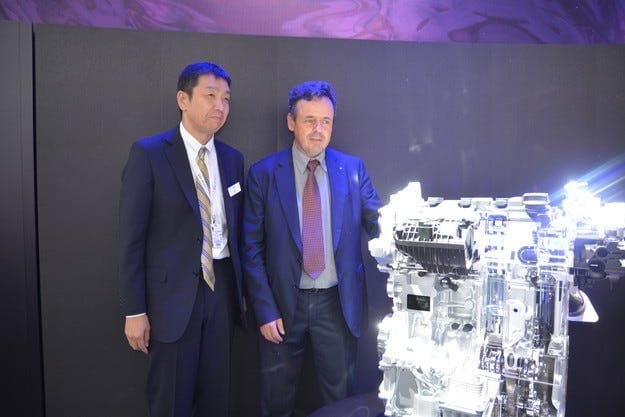
Test drive presentation of the revolutionary motor on Infiniti - VC-Turbo

A conversation with the leading specialists of Infiniti and Renault-Nissan — Shinichi Kaga and Alain Raposteau
Alain Raposto looks confident. The vice-president of the Renault-Nissan alliance, responsible for engine development, has every reason to do so. Adjacent to the hall where we are talking is the stand of Infiniti, the luxury subsidiary of Nissan, which today presents the world's first production engine VC-Turbo with variable compression ratio. The same energy flows from his colleague Shinichi Kiga, head of Infiniti's engine department.
The breakthrough made by the designers of Infiniti is really huge. The creation of a serial gasoline engine with variable compression ratio is truly a technological revolution, which, despite numerous attempts, has not been given to anyone so far. To understand the meaning of such a thing, it is good to read our series "What happens in the car engine", which describes the combustion processes in the gasoline engine. Here we will mention, however, that from a thermodynamic point of view, the higher the degree of compression, the more efficient an engine - very simply put, so the particles of fuel and oxygen from the air are much closer and the chemical reactions are more complete, in addition, the heat is not dissipated outside, but is consumed by the particles themselves.
The high degree of compression is one of the great advantages of the diesel engine over the gasoline one. The brake on the latter is the detonation phenomenon, well described in the series of articles in question. At higher loads, respectively a wider throttle valve (such as when accelerating to overtake), the amount of fuel air mixture entering each cylinder is greater. This means higher pressure and higher average operating temperature. The latter, in turn, causes stronger compression of the fuel-air mixture residues from the combustion flame front, more intensive formation of peroxides and hydroxerxes in the residual and initiation of explosive combustion in the engine, which is typically at extremely high speeds. , a metallic ring and a literal scattering of the energy generated by the residual mixture.
To reduce this tendency at high loads (of course, the tendency to detonation depends on other factors such as external temperature, coolant and oil temperature, detonation resistance of fuels, etc.) designers are forced to reduce the degree of compression. With this, however, they lose in terms of engine efficiency. All this is even more valid in the presence of turbocharging, as the air, although cooled by the intercooler, still enters pre-compressed in the cylinders. This means more fuel, respectively, and a higher tendency to detonation. After the mass introduction of downsizing turbocharged engines, this problem became even more apparent. That's why designers talk about 'geometric compression ratio', that defined by the engine design and 'real' when the pre-compression factor is taken into account. Therefore, even in modern turbo engines with direct fuel injection, which plays an important role in the internal cooling of the combustion chamber and lowering the average temperature of the combustion process, respectively the tendency to detonation, the compression ratio rarely exceeds 10,5: 1.
But what would happen if the geometric degree of compression could change in the course of work. To be high in low and partial load modes, reaching the theoretical maximum and to be reduced at high turbocharging pressure and high pressure and temperature in the cylinders to avoid detonations. This would allow both the possibility of increasing the power with turbocharging with higher pressure and higher efficiency, respectively lower fuel consumption.
Here, after 20 years of work, the Infiniti engine shows that this is possible. According to Raposto, the work the teams put in to create it was enormous and the result of tantalum torment. Different variants have been tested in terms of engine architecture, until 6 years ago this was reached and the precise settings began. The system allows dynamic, stepless adjustment of the compression ratio in the range from 8: 1 to 14: 1.
The construction itself is ingenious: The connecting rod of each cylinder does not transmit its movement directly to the connecting rod necks of the crankshaft, but to one corner of a special intermediate link with a hole in the middle. The unit is placed on the connecting rod neck (it is in its opening) and receiving the force of the connecting rod at one end transmits it to the neck as the unit does not rotate, but performs an oscillating movement. On the other side of the unit in question is a lever system that serves as a kind of support for it. The lever system rotates the unit along its axis, thus displacing the attachment point of the connecting rod on the other side. The oscillating movement of the intermediate unit is preserved, but its axis rotates and thus determines different start and end positions of the connecting rod, respectively the piston and a dynamic change in the degree of compression depending on the conditions.
You will say - but this infinitely complicates the engine, introduces new moving mechanisms into the system, and all this leads to increased friction and inert masses. Yes, at first glance it is so, but with the engine mechanism VC-Turbo there are some very interesting phenomena. The additional units of each connecting rod, controlled by a common mechanism, largely balance the forces of the second order, so that despite its two-liter displacement, the four-cylinder engine does not need balancing shafts. In addition, since the connecting rod does not perform the typical wide movement of rotation, but transmits the force of the piston on one end of the intermediate unit, it is actually smaller and lighter (this depends on the whole complex dynamics of forces transmitted through the system in question). ) and - most importantly - has a deviation course in its lower part of only 17 mm. The moment of the greatest friction is avoided, with conventional engines, typical for the moment of starting the piston from the top dead center, when the connecting rod presses on the crankshaft axis and the losses are the greatest.
Thus, according to Messrs. Raposto and Kiga, the shortcomings are largely eliminated. Hence the benefits of dynamically changing the compression ratio, which is based on pre-set based on bench and road tests (thousands of hours) software programs without the need to measure in real time what is happening in the engine. More than 300 new patents are integrated in the machine. The avant-garde nature of the latter also includes a dual fuel injection system with an injector for direct injection of a cylinder, used mainly for cold starts and higher loads, and an injector in the intake manifolds providing better conditions for fuel displacement and a smaller energy consumption at partial load. Thus the complex injection system offers the best of both worlds. Of course, the engine also requires a more complex lubrication system, as the mechanisms described above have special pressure lubrication channels, which complement the main channels in the crankshaft.
The result of this is practically that the four-cylinder gasoline engine engine with 272 hp. and 390 Nm of torque will consume 27% less fuel than the previous atmospheric six-cylinder engine with close to this power.
Text: Georgi Kolev, special envoy of auto motor und sport Bulgaria in Paris
